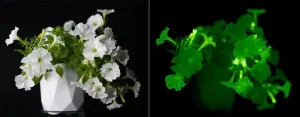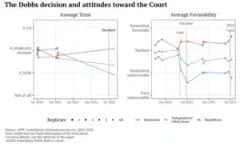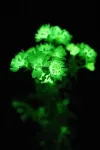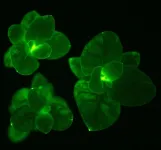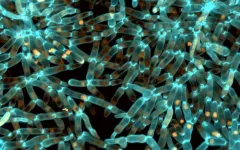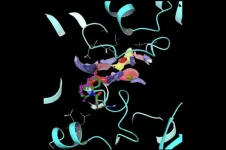Sun Valley, ID - March 8, 2024 – Recent discoveries published in Science Advances have unveiled a native plant gene that enables researchers to more effortlessly harness the captivating glow of bioluminescent plants. This gene, which varies across different plant species, allows for the redirection of living energy into organic light. The advancement reveals the intricate inner rhythms and dynamics of plants through continuously evolving luminosity, offering a natural source of illumination for homes, gardens, and beyond.
The study received support from Light Bio, a pioneer in the development of bioluminescent plants. Light Bio is dedicated to fostering greater connection and enjoyment of plants through the enchanting appeal of living light.
The latest research builds upon earlier findings, showing that the natural glow of luminous mushrooms aligns seamlessly with central metabolic processes in plants. Utilizing a gene native to plants further amplifies this bioluminescent harmony, optimizing the interplay between light production and energy utilization.
Prior approaches for creating bioluminescent plants involved incorporating five genes derived from fungi. In the new findings, a solitary gene indigenous to plants can effectively substitute for two of the fungal genes. The plant gene's compact size and simpler biological requirements enhance its versatility for diverse applications.
The compact gene plays a pivotal role, acting as a bridge between plant metabolism and light production. This connection allows the plant’s inner dynamics to be translated into a constantly changing spectacle of natural light.
Bioluminescent plants have garnered immense popularity among the public. Light Bio recently began taking orders for a bioluminescent petunia under the brand Firefly™ Petunia, so named because the bright buds resemble fireflies. The petunia emits a soft glow similar to moonlight.
Keith Wood, the CEO of Light Bio, reports that the Firefly Petunia is selling fast. He says that “sales for this remarkable plant have been impressively robust. We've had to ramp up production twice already to keep pace with the demand."
The company selected the petunia as its inaugural offering due to its popularity as an ornamental plant. Light Bio recently announced that their plants glow up to 100 times brighter than previously possible, with the petunia standing out as the most radiant. Known for their ease of cultivation and prolific flowering, petunias make an ideal choice for this innovative enhancement.
In September, following an independent review, the USDA concluded that the Firefly Petunia is safe for cultivation and breeding across the United States. Available for purchase at $29 USD per plant from Light Bio's website (www.light.bio), the petunia is set to start shipping in April to all 48 contiguous US states.
In partnership with Ginkgo Bioworks, Light Bio envisions future plants to be at least ten times brighter, with an expanded range of varieties and colors. Beyond the sheer delight these luminous plants provide, the foundational science offers profound insights into plant molecular physiology. The collaborative teams are confident that discoveries from this research will lead to significant progress in essential fields such as crop development and disease resistance.
For more information on Light Bio and the Firefly Petunia, please visit
www.light.bio.
About Light Bio
Founded in 2019, Light Bio is a pioneering synthetic biology startup focused on cultivating vibrant bioluminescent plants. Through the melding of proprietary technology and advanced genetic engineering, Light Bio is bringing the magic of living light to ornamental horticulture. The company enjoys robust backing from industry leaders such as NFX, Ginkgo Bioworks, and others. To learn more, please visit www.light.bio and follow on X (formerly known as Twitter) @Light_Bio, Instagram @Light.Bio, and LinkedIn.
About Ginkgo Bioworks
Ginkgo Bioworks is the leading horizontal platform for cell programming, providing flexible, end-to-end services that solve challenges for organizations across diverse markets, from food and agriculture to pharmaceuticals to industrial and specialty chemicals. Ginkgo's biosecurity and public health unit, Concentric by Ginkgo, is building global infrastructure for biosecurity to empower governments, communities, and public health leaders to prevent, detect and respond to a wide variety of biological threats. For more information, visit ginkgobioworks.com and concentricbyginkgo.com, read our blog, or follow us on social media channels such as X (formerly known as Twitter) (@Ginkgo and @ConcentricByGBW), Instagram (@GinkgoBioworks and @ConcentricByGinkgo), Threads (@GinkgoBioworks) or LinkedIn.
Forward-Looking Statements of Ginkgo Bioworks
This press release contains certain forward-looking statements within the meaning of the federal securities laws, including statements regarding the capabilities and potential success of the partnership and Ginkgo's cell programming platform. These forward-looking statements generally are identified by the words "believe," "can," "project," "potential," "expect," "anticipate," "estimate," "intend," "strategy," "future," "opportunity," "plan," "may," "should," "will," "would," "will be," "will continue," "will likely result," and similar expressions. Forward-looking statements are predictions, projections and other statements about future events that are based on current expectations and assumptions and, as a result, are subject to risks and uncertainties. Many factors could cause actual future events to differ materially from the forward-looking statements in this press release, including but not limited to: (i) volatility in the price of Ginkgo's securities due to a variety of factors, including changes in the competitive and highly regulated industries in which Ginkgo operates and plans to operate, variations in performance across competitors, and changes in laws and regulations affecting Ginkgo's business, (ii) the ability to implement business plans, forecasts, and other expectations, and to identify and realize additional business opportunities, (iii) the risk of downturns in demand for products using synthetic biology, (iv) the uncertainty regarding the demand for passive monitoring programs and biosecurity services, (v) changes to the biosecurity industry, including due to advancements in technology, emerging competition and evolution in industry demands, standards and regulations, (vi) our ability to realize the expected benefits of merger and acquisition transactions, (vii) the outcome of any legal proceedings against Ginkgo, including as a result of recent acquisitions, (viii) our ability to realize the expected benefits from and the success of our Foundry platform programs, (ix) our ability to successfully develop engineered cells, bioprocesses, data packages or other deliverables, and (x) the product development or commercialization success of our customers. The foregoing list of factors is not exhaustive. You should carefully consider the foregoing factors and the other risks and uncertainties described in the "Risk Factors" section of Ginkgo's quarterly report on Form 10-Q filed with the U.S. Securities and Exchange Commission (the "SEC") on November 8, 2023 and other documents filed by Ginkgo from time to time with the SEC. These filings identify and address other important risks and uncertainties that could cause actual events and results to differ materially from those contained in the forward-looking statements. Forward-looking statements speak only as of the date they are made. Readers are cautioned not to put undue reliance on forward-looking statements, and Ginkgo assumes no obligation and does not intend to update or revise these forward-looking statements, whether as a result of new information, future events, or otherwise. Ginkgo does not give any assurance that it will achieve its expectations.
LIGHT BIO CONTACT:
hello@light.bio
GINKGO BIOWORKS INVESTOR CONTACT:
investors@ginkgobioworks.com
GINKGO BIOWORKS MEDIA CONTACT:
press@ginkgobioworks.com
END
